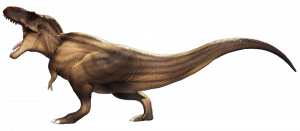Tyrannosaurus rex
Tyrannosaurus Rex (T.rex/T-Rex) had lived throughout what is now known as western North America, on a former island continent known as Laramidia. Tyrannosaurus had a much wider range than other tyrannosaurids. It lived during the Maastrichtian age of the upper Cretaceous Period, from 68 to 66 million years ago, and is one of the strongest and largest carnivores in the Beast of Bermuda islands.
Information
The Tyrannosaurus is by far the strongest terrestrial carnivore in-game. With a bite attack that does 450 damage, it can kill all but the largest animals in a few hits. However, its power is curtailed by having an extremely small pool of stamina. This makes the Tyrannosaurus an ambush hunter. Unlike the Acrocanthosaurus, which is a persistence hunter, the Tyrannosaurus rex is forced to lie in wait, hidden among the foliage, until a prey item passes by. If its attack does not connect and do the necessary injury damage to cripple its prey's movement, it will be left in the dust.
Unique Ability: The Tyrannosaurus rex is the largest predator on the islands. The T-rex is very fast, more than an acro but it is the creature that has the least stamina. The element of surprise is paramount for success with this creature, as it's ability is still being determined and might not even have one, depending on its gameplay.
Other Facts: The Tyrannosaurus have a feathered and scaly variant.
Tips
Trivia
Gallery
A feathered rex drinking from a freshwater lake.]]
References


